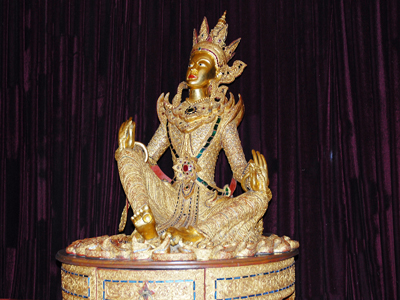Lawkanat, the peacekeeper
To the people of Myanmar Lawkanat is the symbol of peace and prosperity and his figures are displayed prominently in our art, culture and the Theravada religion. The role of the Lawkanat as peacemaker is based on a fascinating legend handed down through the generations.

Legend of the Peacekeeper
The legend said, once upon a time, the Guardian Spirit of the universe, known as the Loka Byuha Nat or Lawkanat was making the rounds of his domain, when he came upon the Kethayaza Chinthemin, King Lion, and the Flying Elephant locked in mortal combat. The fight had broken out over attempts to grab the lacy tender clouds which were the favourite food for both. Now both the lion and the elephant each wanted the food for his own and were ready to fight a mortal combat for it.
The Lawkanat, in his supernatural power, foresaw that should the combat intensify and become more violent, then the entire earth would be set ablaze. Thus, to put an end to their hostility he instead plants love and amity between them, by starting to play a rhythmic beat on his small musical timing cymbals, sing in his melodious voice and dance to melody.
The two combatants hearing the soothing voice in song and seeing the graceful dance calmed down and stopped their fight. Thus, their resentment and animosity diminished and the fire of their wrath was extinguished.
The Name
The term Lawkanat in popular usage today is also said to be derived from the name of a deity named Lokanahta, which is the combination of two Pali words, Loka, meaning people in general and Nahta, meaning heavenly being. So the Lawkanat was originally the title of the deity who is believed to keep eternal watch over the world. Later it came to denote a prince or a ruler whose benevolence and wisdom protected the people of the kingdom and bestowed good fortune. The renowned Buddhist monk Shin Maharahtathara, in Myanmar literature referred to King Saw Bramhadatt as Lawkanat in his epic poem about Buridhatt, the future Buddha.
He is regarded as a gentle peacemaker and seemed to have captured the innovative imagination of creativity, by artists. Myanmar sculptors and painters have fantasized greatly in their portrayals of many celestial beings and deities, but the figure of the Lawkanat is different and special. He is always portrayed in a sitting position, slightly different from the original posture of Avalokitesvara, on a pedestal with a lotus-shaped platform. His posture is singular, sitting with one knee raised and the other laid down flat in a curved position with his feet clutching the musical timer cymbals. The hands are raised in a dance choreography with the delicacy and grace and suppleness of a bird's wing in flight; the face is a study of serenity, yet the upward tilt of the chin brings to it a touch of light and joy. It is no wonder that for us, the Lawkanat figure has become synonymous with peace joy and artistry.
Cultural view
The Lawkanat is the favourite subject of Myanmar's sculpture and painting. In fact many will say that the Lawkanat is the logo of the visual arts in Myanmar. Its graceful figure is also frequently seen adorning the Myanmar traditional orchestra, for he is regarded the patron of the performing arts as well. In fact, the Lawkanat stands for peace and harmony, happiness and joy and all that is right and good. The figure is often placed in a prayer chamber or throne room. A Lawkanat figure has been placed in the foreground of the Thihathana Throne now on display at the National Museum.
The lotus leaf pedestal of the Lawkanat represents a leaf struggling out of the grip of the murky depths of a pond to emerge fresh and green on the water's surface, and the entwining vines are like wavelets lapping at the edges. For the Myanmar people, a lotus leaf signifies peace and purity, an escape from the frailty of mundane life into the sunlight of wisdom and truth. This is in complete harmony with the celestial figure which stands for peace and serenity.





